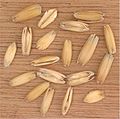Difference between revisions of "AY Honors/Bird Pets/Answer Key"
| Line 29: | Line 29: | ||
Image:Rapeseed.jpg|3. Rape Seed | Image:Rapeseed.jpg|3. Rape Seed | ||
Image:Linum usitatissimum (linseed).jpg|4. Linseed | Image:Linum usitatissimum (linseed).jpg|4. Linseed | ||
| − | 5. Poppy Seed | + | Image:Papaver somniferum seeds paso2 002 php.jpg|5. Poppy Seed |
</gallery> | </gallery> | ||
Revision as of 02:15, 28 June 2008
Template:Honor header Template:AY Master Template:AY Master
1. Keep one or a pair of birds for at least six months.
2. Show you have completed one of the following:
a. If you have a cage bird, keep a record of its care for at least one month. Include food habits, water needs, cage cleaning, etc.
b. If you do not have a cage bird now but completed requirement #1 in the past, take care of some one else's bird for at least one week while they are on vacation, etc., and maintain a record of the required care.
3. Canaries
a. Give the names of four varieties of canaries.
Canaries are generally divided into three main groups, with each group having several varieties:
- Colorbred Canaries (bred for their many color mutations - Ino, Eumo, Satinette, Bronze, Ivory, Onyx, Mosaic, Brown, etc.)
- Type Canaries (bred for their shape and conformation - Border, Fife, Gloster, Gibber Italicus, Raza Española, Berner, Lancashire, Yorkshire, Norwich, etc.)
- Song Canaries (bred for their unique and specific song patterns - Spanish Timbrado, Roller, Waterslager (also known as "Malinois"), American Singer, Russian Singer, Persian Singer).
b. Give a brief history of the origin and development of canaries.
The canary is a domesticated form of the Wild Canary, (Serinus canaria) a small songbird in the finch family originating from Madeira and the Canary Islands.
Canaries were first bred in captivity in the 1600s. They were brought over by Spanish sailors to Europe. Monks started breeding them and only sold the males (which sing). This kept the birds in short supply and drove the price up. Eventually Italians obtained hens and were able to breed the birds themselves. This made them very popular and resulted in many breeds arising and the birds being bred all over Europe.
The same occurred in England. First the birds were only owned by the rich but eventually the local citizens started to breed them and, again, they became very popular. Many breeds arose through selective breeding.
c. Name and distinguish five seeds used in canary feeding.
d. Describe briefly the general care of canaries.
4. Parakeets or love birds
a. To what country are parakeets or love birds native?
Parakeets originally come from Africa and Australia. Love birds originally come from Africa.
b. Describe briefly their habits of feeding, nesting, and general behavior.
Parakeets: They don’t like to live together in colonies. The most that a large cage should accommodate is 2. They can however be kept with pigeons, pheasants or finches. They eat mixed varieties of seed such as budgie seed and oats. They also like their green feed such as spinach, cabbage and lettuce. Boiled egg can be added during the breeding season. They also need grass and palm leaves to build their nests.
Love Birds: They sleep in nests throughout the year and therefore should be provided with such or should be provided with the materials to weave their own. This includes palm leaves, papyrus, reeds, and grass. They eat a variety of seed such as sunflower seed, oats, canary seed and whit- yellow- or red millet. They can also have boiled eggduring the breeding season and are also very fond of green feed. (spinach lettuce etc)
5. Pigeons
a. Name and identify six varieties of pigeons.
Adventist Youth Honors Answer Book/Nature/Birds/Rock Pigeon
Adventist Youth Honors Answer Book/Nature/Birds/Stock Pigeon
Adventist Youth Honors Answer Book/Nature/Birds/Wood Pigeon
Adventist Youth Honors Answer Book/Nature/Birds/Band-tailed Pigeon
Adventist Youth Honors Answer Book/Nature/Birds/Turtle Dove
Adventist Youth Honors Answer Book/Nature/Birds/White-tipped Dove





